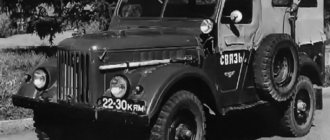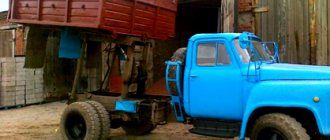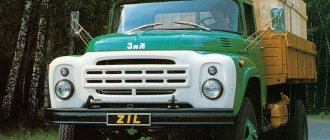ZIL-131 is a Soviet-Russian production truck, developed on the basis of the original ZIL-130 model. It is an all-terrain vehicle created by the designers of the Likhachev plant. This model replaced the Soviet ZIL-157 truck. It should be noted that most of the ZIL-131 vehicles produced were delivered to the Soviet Army. Production of ZIL-131 began in 1966 and continued until 2002. ZIL-131 exists only in all-wheel drive and with a front-engine layout. The successor to the ZIL-131 is the ZIL-4334 model. Similar models include the KrAZ-255B, as well as the Ural-4320 and Ural 375D.
ZIL 131 kung 2 doors. van, 150 hp, 5 manual transmission, - increased fuel consumption
Gasoline consumption in ZIL-131 per 100 km depends on the modification of the vehicle. The manufacturer took care of the reinforced chassis design. Thanks to this, developers were able to install a variety of add-ons. They allowed the vehicle to be used in different areas and areas. If we compare previous models, the fuel consumption in the ZIL-131 is several times lower. The manufacturer took care of improving the power steering and the presence of a tire pressure monitoring system. The driver will be able to easily overcome difficult obstacles and obstacles with minimal fuel consumption. Thanks to the winch, you can pull out equipment or cars that are stuck. Available modifications:
- Flatbed truck. This is a classic version, which is equipped with a wooden body. The frame is made entirely of sheet metal. All sides are in a closed state, except for the rear part. In the inner part of the body there are benches that are located along the sides. Total capacity up to 16 people. This modification has additional protection that prevents foreign objects and particles from getting inside the motor.
- Manipulator. This modification attracts attention with its increased level of strength. For production, high quality carbon steel is used, which is used for the frame and body. Manipulators consume more fuel when they perform the function of a crane and are equipped with additional equipment.
Previously, dump trucks were produced, but they were not economical to operate and maintain. Previously they were used in construction.
Cabin and body
In this form, with flatbed bodies, the first vehicles were produced and immediately entered service with the army, came to collective farms, and to large construction sites. Slightly modernized, on-board vehicles with a winch and a platform above the top of the cabin, additional lighting, and marked with special signs, provided the missile systems with special equipment, carried out reloading and delivery of equipment.
Vehicles of the chemical defense troops
The ZIL-131 marked the heyday of Soviet engineering vehicles for the construction of ground structures and bridges, search and desalination of water, creation of drilling stations, means of self-excavation of trucks, accelerated mining and unique semi-floating bridges. Clutch type 24 Gearbox type 182EM 6ST-132EM Number of stages Synchronizers Transfer case type Transfer case gear ratio First stage 2.08 1 Second stage 1 1 Main gear type Double Main gear ratio 7.339 1 Rear axle drive Sequential through.
ZIL-130 • Consumption of ZIL 131 per 100 km gasoline
If not for this, and if work on improving the model had continued in due time, it is likely that the modern version would easily give odds to most similar equipment, even imported ones. Yes, it has high fuel consumption for this class, from 25 to 35 liters per 100 km, depending on the road and load, but it is completely undemanding in terms of fuel quality and pulls without problems.
| Check the condition of the air filter replacement element | Blow or replace the air filter element | |
| Leaking power system | Smell of gasoline, fuel leaks | Check the tightness of the connections of the fuel system elements; If a malfunction is detected, replace the corresponding components |
| Spark plugs are faulty: current leakage through cracks in the insulator or carbon deposits on the heat cone, poor contact of the central electrode | Spark plugs are checked on a special stand at a service station. The absence of external damage and sparking between the electrodes on the inverted spark plug does not allow us to draw a conclusion about its functionality | Replace spark plugs |
| Throttle actuator malfunction | Check the travel of the gas pedal, the clearance in the drive (free play of the pedal), make sure that the cable and pedal are not jammed | Replace faulty parts, lubricate the cable with engine oil |
| The idle speed controller or its circuits are faulty | Replace the regulator with a known good one. | Replace the faulty regulator |
| The throttle valve does not close completely | The gap between the throttle valve and the walls of the housing is visible in the light | Replace the throttle assembly |
| Increased pressure in the fuel line due to a faulty pressure regulator | Check the pressure in the fuel system with a pressure gauge (no more than 3.5 bar) | Replace the faulty regulator |
| Leaking injectors | Check the injectors | Replace faulty injectors |
| The coolant temperature sensor or its circuit is faulty | Check the sensor resistance with an ohmmeter at different temperatures | Restore contact in electrical circuits, replace the faulty sensor |
| The oxygen concentration sensor is faulty | You can evaluate the performance of the oxygen concentration sensor and the reliability of its electrical circuit connections using diagnostic equipment at a service station | Restore damaged electrical circuits, replace faulty sensor |
| The ECU or its circuits are faulty | To check, replace the ECU with a known good one. | Replace the faulty ECU, restore damaged electrical circuits |
| Low compression in the engine cylinders (less than 11.0 bar): clearances in the drive are not adjusted, wear or damage to the valves, their guides and seats, stuck or broken piston rings | Check compression | Adjust the clearances in the valve drive. Replace faulty parts |
| The throttle position sensor, absolute pressure and air temperature sensors in the intake manifold or their circuits are faulty | Check the sensors and their circuits | Restore contact in the electrical circuits, replace the faulty sensor(s) |
| Increased resistance to gas movement in the exhaust system | Inspect the exhaust system for dented or damaged pipes, check the condition of the catalytic converter | Replace damaged exhaust system components |
| Malfunctions of the chassis and brake system | Check the chassis and brake system | Adjust the wheel alignment angles, replace faulty chassis parts, and troubleshoot the brake system. |
Peculiarities
Based on the universal chassis of the specified truck, various modifications of special vehicles were produced. Among them:
- Fire trucks.
- Fuel trucks and fuel tankers.
- Oil refillers.
- Tank trucks.
- Airfield tractors with increased weight.
For military laboratories, workshops, radio stations, and headquarters versions, standard universal, sealed bodies were used. They were equipped with special filtration systems that take air masses from outside and supply them to the van, while simultaneously disinfecting the interior.
KUNG from ZIL 131, dimensions and weight:
- length - 4.8 m;
- height - 1.95 m;
- width - 2.2 m;
- weight (dry/curb) - 1.5/1.8 t.
As many years of practice have shown, the ZIL 131 has proven itself to be a reliable, durable and easy-to-maintain truck. Its main advantage is its high cross-country ability, which guarantees passage with a full load of washed-out and clayey areas. An additional bonus is the presence of a reduction gear, and mechanical tire inflation allows you to adjust the tire pressure, depending on the road surface and axle load.
In addition, drivers note a relatively comfortable cabin and easy access to main parts, which increases the machine’s maintainability. Despite the fact that the serial production of this vehicle was completed many years ago, it can still be found in various sectors of the economy.
Video: Consumption of ZIL 131 per 100 km gasoline
| ZIL-131: the best Soviet military truck: pedigree of an army vehicle - - automobile magazine At the 1L117 long-range detection observation station, two ZIL-131 trucks with special bodies were used at a distance of up to 350 km, in which the equipment of the transceiver station and the primary and secondary processing cabin were mounted information received. Recently, a new product called a fuel saver has appeared in the field of automotive technology, which, according to manufacturers and sellers, can reduce fuel consumption. |
| Endless military professions of the ZIL-131 truck - - automobile magazine fuel consumption Mercedes 2 2 diesel, Hyundai Tucson 2 0 gasoline consumption, Highlander 3 5 gasoline consumption, Kia Rio gasoline consumption 1 4, Nissan Navara 2 5 diesel automatic. The 131B series militarized truck tractors typically operated in conjunction with standard single- and dual-axle semi-trailers designed for the Ministry of Defense and transported large cargo, bridge sections, and bridge construction equipment. |
- Use of wide-profile rubber, which is not provided by the manufacturer. You should not install decorative spoilers or additional grilles on your truck. The car body has a streamlined shape that does not interfere with air flow while driving.
- Consumers of electrical energy that are constantly on. To save money, they need to be turned on only when necessary. If you install air conditioning inside the cabin, it will increase fuel costs by 0.8 liters (for every 50 km).
- Warming up the engine to optimal operating temperature after starting at idle. It is recommended to move faster. It has been verified that under load the motor begins to warm up several times faster.
- During operation, the engine must operate at speeds that correspond to the maximum permissible torque. You can find this information in the technical documentation or look at the accompanying document for the truck.
- Prudent, proportionate driving helps to save fuel. You can plan your route in advance when driving long distances. To save money, the driver needs to avoid sudden, additional accelerations and driving at maximum speed. Before a traffic light, you need to take your foot off the gas pedal in advance. Coasting downhill helps minimize fuel costs.
- The driver should check the tire pressure level daily. When a deficiency occurs, rolling resistance increases. Incorrect tire pressure levels result in poor vehicle stability. Tires begin to wear out faster.
A little about the car • After all, bad fuel burns worse, provides an insufficient amount of energy and requires additional energy consumption.
Video
The Likhachev plant produced many modifications of the model. Among them:
- ZIL-131 – basic modification, production of which lasted from 1967 to 1986;
- ZIL-131A is a version with unshielded electrical equipment migrated from the ZIL-130. Its differences from the basic version were the absence of special military equipment, a middle bench in the body and a searchlight. Production of the car ended in 1971;
- ZIL-131V is a truck tractor built on the basis of the ZIL-131. The car had 2 spare wheels, a shortened frame and a fifth wheel coupling. The car was used to transport goods together with a semi-trailer weighing 12,000 kg (on dirt roads - 10,000 kg). Produced from 1968 to 1986;
- ZIL-131D – experimental chassis for dump trucks;
- ZIL-131D is a model with the same name and a Caterpillar engine, created in 1992. Its production lasted 2 years;
- ZIL-131N is a modernized version of the basic model. The main differences: a new ZIL-5081 engine, an increased service life (250 thousand km), an awning made of synthetic material and improved optics. Production of the ZIL-131N ended in 1987;
- ZIL-131NA – analogue of ZIL-131N with unshielded electrical equipment;
- ZIL-131NV – truck tractor with an improved platform;
- ZIL-131N1 – modification with a 105-horsepower diesel unit “D-245.20”;
- ZIL-131N2 – version with a 132-horsepower diesel unit “ZIL-0550”;
- ZIL -131S and ZIL -131AS are northern versions. These models were equipped with a cabin with an autonomous heater, frost-resistant rubber products, additional thermal insulation, fog lights, battery insulation and double glass. Cars were used in temperatures down to -60 degrees;
- ZIL-131NS, ZIL-131NAS and ZIL-131NVS - improved versions in the northern version;
- ZIL-131X - model for desert and hot areas;
- ZIL-131-137B – road train.
Device
The power unit of the car is located under the hood. The cabin is all-metal and accommodates two passengers and a driver. The driver and passengers seats are separate. The driver can adjust his seat in horizontal and vertical planes, as well as adjust the backrest tilt.
The ZIL-131 cabin was copied from the civilian 130 version - but the soldiers did not like it. After several batches were produced, it was replaced with a cabin from the ZIL-165. The car turned out to be more comfortable, the windshield became panoramic, it now consisted of two parts and provided a wide view.
ZIL-131 was similar to other domestic off-road trucks. Its main competitors were the Ural-375 and ZIL-157K. The similarity of these machines is explained by the uniform Soviet standard in force when designing such equipment. Differences could be noticed in some components and in different approaches to production.
For many years, engineers have been trying to solve a difficult problem: how to reduce the cost of a car and not lose a high level of performance characteristics? As a result, the problem was resolved, resulting in the birth of a high-quality, reliable product. After the release of the 131st, they planned to curtail the production of the 157th, however, they were produced in parallel for the next 20 years.
Exterior and cabin
Like most of their models, ZIL made the “131” model with a hooded body layout. The cabin was externally an exact copy of the 130, only mostly all samples were painted khaki.
The design also remains all-metal. Proving to be impractical, the front part was replaced, and again with a ready-made one, only now from the ZIL-165. The bent fenders and intricate grille shape were replaced with simpler but strict elements.
In the 60s of the last century, such a design was akin to revolutionary, not to mention comparing the new model with the “157” model. For almost forty years, the appearance of the military truck changed only in small details. What catches your eye most is the new windshield, which has been made panoramic.
It was not advisable to hide the engine under the cabin, since this negatively affected several factors at once: access to the engine compartment in the field worsened, and if the engine was damaged during combat operations, an increased danger was created.
Considering the focus on army needs, the appearance was similar to its other brother in the class - Ural-375. There was one country, and enterprises were completely subordinated to the state. The main differences were different solutions to technical issues and engineering structures.
The body had typical characteristics, having on board two folding benches and one removable one. The sides cannot be folded down, except for the rear one, but this does not interfere with convenient shipping and loading.
To stretch the awning, you can install special arcs. The structure of the vehicle made it possible to install other modules instead of a cargo body, such as a field kitchen, a first-aid post, a radio station, and Katyusha and S-125 missile launchers; as well as civilians - a boom with a cradle, a fire truck.
It was comfortable to be inside due to several innovations. The already mentioned windshield has significantly improved visibility compared to the previous version of the “157”. Improved thermal insulation allows you to drive the car warmly, even in winter frosts.
The driver's seat was separate from the double passenger seat and was adjustable in height, reach and backrest angle. The dashboard has a minimum number of sensors that provide the driver with all the necessary information:
- Gasoline level;
- Voltmeter/ammeter;
- Speedometer;
- Oil pressure;
- Temperature level;
- Tachometer.
Of the controls, only one is located on the steering column - the turn lever. Large mirrors provide a good view of the rear view, reducing the blind spot to a minimum, even with a trailer.
Consumption rate: Basic modifications
| Fuel consumption for ZIL 131 Aerial platform At the end of the 70s, the only and unsuccessful attempt to switch to a new military vehicle was experimental samples of the ZIL-131M with a multi-fuel V8 engine of 170 horsepower, an elongated hood and different versions of the front end cladding. The service life of all the main components is an order of magnitude higher than indicated, we can say that the car is practically indestructible, plus instead of the standard 5-6 tons, you can safely load up to 7-9 tons. |
- maximum speed – 85 km/h;
- maximum speed in a road train is 75 km/h;
- braking distance at a speed of 50 km/h – 29 m;
- run-out from 50 km/h – 450 m;
- maximum climbable height – 60%;
- the maximum climbable grade in a road train is 36%.
- the minimum turning radius of the vehicle is 10.8 m, and the fording depth is 0.9 m.
Reasons for the appearance and purpose of a military truck
Thus, the VIP version of the ZIL 131 with a KUNG equipped for hunting and fishing, which includes a power station, an internal network for 12 and 220 volts, a TV, a heater, a stove, fabric trim, a safe, is offered for 650 thousand. But at the same time in an open field or You cannot install such devices in a tent, and people working with them must be in relatively comfortable conditions.











